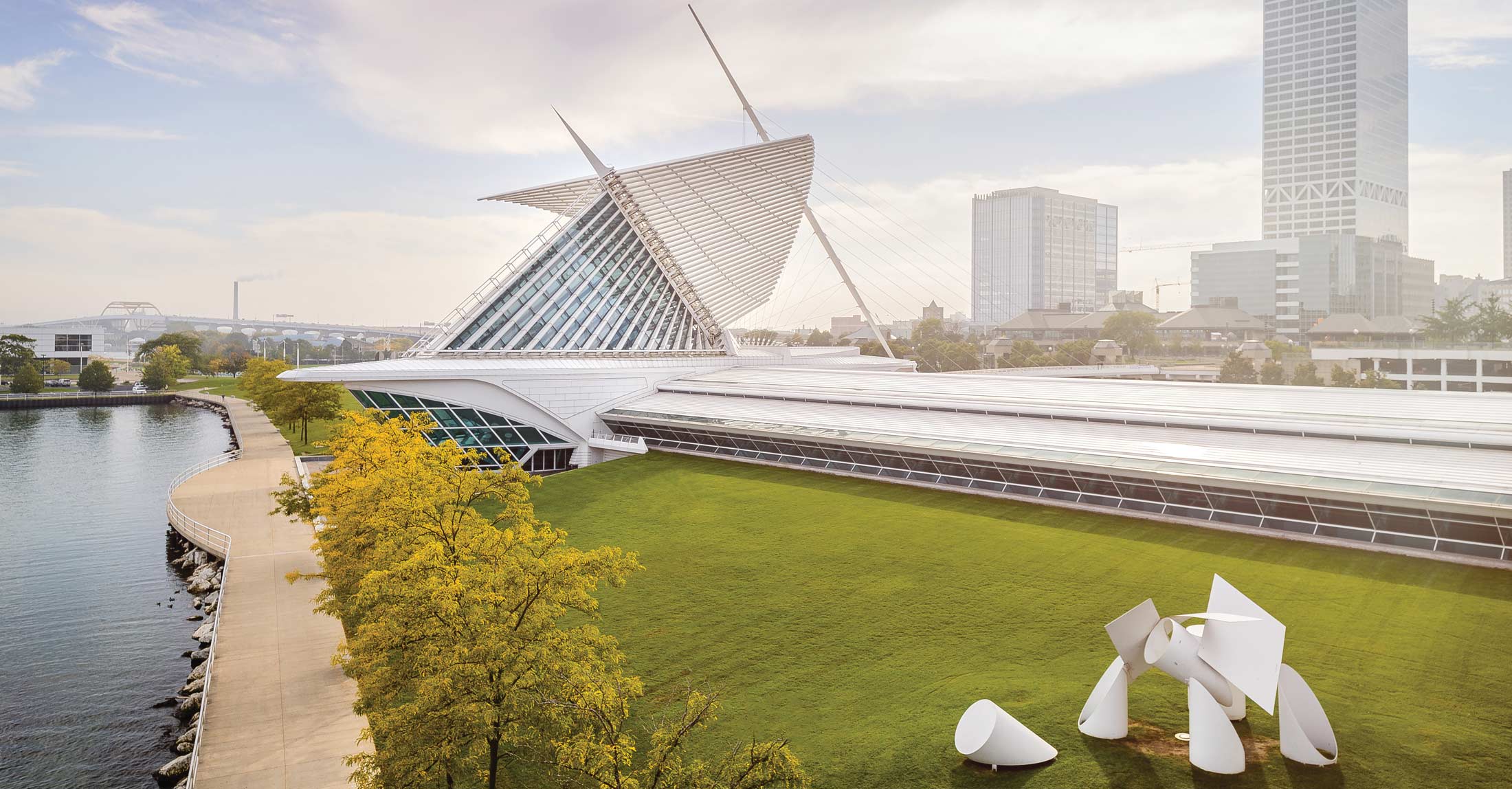
A New Story Emerges: Introducing Homelands: Mnë’nának, Māēnāēwah, Tešišik
The title of the reinstallation—which centers Native voices in American art—reflects Milwaukee’s Indigenous roots as a gathering place where land meets water.


MILWAUKEE, WI—June 25, 2025—The Milwaukee Art Museum unveiled Homelands: Mnë’nának, Māēnāēwah, Tešišik—a groundbreaking reinstallation of its former “American West” gallery—on Saturday, June 21. Developed with the institution’s Native Initiatives Advisory Group (NIAG) and supported by a major grant from the Terra Foundation for American Art, the new presentation, co-curated by Chyna Bounds and Kendra Greendeer, PhD, foregrounds contemporary Native art and reinterprets historical works, centering Indigenous voices and honoring the region’s cultural roots through the themes of land and water.
Homelands reasserts Native voices to tell a more comprehensive American art history. Milwaukee is, and always has been, home to Indigenous people with diverse tribal affiliations, and the reinstallation honors these communities by bringing Native art into the spotlight. It invites visitors to consider how Native artists depict the landscapes they live in, reflect on their relationships with land and water, and express the deep cultural and spiritual significances these natural resources hold for Native communities. While the presentation includes art from beyond the Great Lakes region, it maintains a focus on Wisconsin and the western Great Lakes. Its title reflects Milwaukee’s Indigenous roots as a gathering place where land meets water: mnë’nának* (Potawatomi) for “the good land,” Māēnāēwah (Menominee) for “some misfortune happens,” and Tešišik (Ho-Chunk) for “bad lake.”
“The works by contemporary artists depict Indigenous art, culture, and traditions in Wisconsin and beyond as they have always been: vibrant, enduring, and thriving,” said the reinstallation’s co-curator Kendra Greendeer, PhD, member of the Ho-Chunk Nation, descendent of the Red Cliff Band of Lake Superior Ojibwe, and Ihlenfeld Curator of Collaborative and Community Exhibitions at Weisman Art Museum in Minneapolis, Minnesota.
Highlights from the reinstallation include:
- Falling Buffalo (1973) by Fritz Scholder (Luiseño, 1937–2005) exemplifies how the artist challenges romanticized narratives through bold, visceral imagery.
- Feather Canoe (ca. 1993) by Truman Lowe (Ho-Chunk, 1944–2019) emphasizes lightness and fluidity to evoke the experience of gliding across water.
- Exit (2018) by Andrea Carlson (Ojibwe, b. 1979) exemplifies how the artist brings visibility to ancestral Indigenous societies through contemporary and traditional motifs.
The reimagined presentation of works of Native art tells a narrative of cultural affirmation, creative expression, and truth-telling. With guidance from the Native Initiatives Advisory Group, it also challenges the one-sided narrative about the “American West” seen in historical works by non-Native, Anglo-American artists. NIAG is composed of Native American activists, curators, educators, and knowledge-keepers from tribal nations across Wisconsin and, together with Museum staff, they reexamine how the institution presents art by and about Indigenous communities. In Homelands, NIAG members bolster the curator-authored labels by contributing personal reflections. Their powerful responses to historical paintings—such as Entrapped Otter (Canadian Otter) (1827/30) by John James Audubon and View on the Fox River (ca. 1885–88) by Henry Vianden—invite visitors to engage with these objects from multiple perspectives.
“I’m delighted to welcome visitors to Homelands, a significant project that has been three years in the making with guidance from our generous and thoughtful partners in the Native Initiatives Advisory Group,” said the reinstallation’s co-curator Chyna Bounds, assistant curator of American decorative arts and design at the Milwaukee Art Museum. “The new presentation forefronts Native stories and voices, making the collection more reflective of and relevant to Milwaukee’s community. It creates a space where visitors can see themselves in the art and feel a sense of belonging, celebration, and inspiration.”
The Museum opened Homelands on Saturday, June 21. This fall, November 13–16, the Museum will host a public symposium with the Native Initiatives Advisory Group to discuss the reinstallation and its significance.
The Native Initiatives Advisory Group formed in 2021. Prior to their guidance on Homelands, NIAG supported interpretation and programs for the exhibitions Shifting Perspectives: Landscape Photographs from the Collection (2022) and Native America: In Translation (2023). In 2023, they collaborated with the Museum to host Family Sundays: Celebrating Native Art and Artists, which lauded Indigenous cultures and creativity with a day-long program of art making, performances, and tours.
For more information about Homelands, visit the Museum’s website to engage with the reinstallation’s dedicated microsite: mam.org/homelands.
* The bodwéwadmimwen (Potawatomi) language does not use capital letters.
Support
Homelands: Mnë’nának, Māēnāēwah, Tešišik is made possible through support from the Terra Foundation for American Art.
About the Terra Foundation for American Art
The Terra Foundation for American Art expands narratives of American art through our grants, collection, and initiatives. With offices in Chicago and Paris, we work with organizations to foster intercultural dialogues and encourage transformative practices, locally and globally.
The Milwaukee Art Museum extends its sincere thanks to the Visionaries.
Mark and Debbie Attanasio
Donna and Donald Baumgartner
Murph Burke
The Helmerich Trust
Kenneth and Alice Kayser
Joan Lubar and John Crouch
Joel and Caran Quadracci
Sue and Bud Selig
Jeff and Gail Yabuki
About the Milwaukee Art Museum
The Milwaukee Art Museum is an essential destination for art and architecture and a vital cultural resource that connects visitors to dynamic art experiences and one another. Housed in iconic buildings by Santiago Calatrava, Eero Saarinen, and David Kahler on a 24-acre lakefront campus, the Museum is Wisconsin’s largest art institution and home to both broad and deep collections, with exceptional holdings in American painting, sculpture, and decorative arts; conceptual and minimalist art; prints and drawings; European art from the Renaissance through the nineteenth century; photography and new media; modern and contemporary design; folk and self-taught art; and twentieth-century Haitian art. A bold symbol of Milwaukee’s ambition and forward-thinking vision, the Museum is a place for community building, education, and celebration that fosters creativity, free speech, and critical discourse for audiences of all ages and backgrounds. For more information, visit mam.org.
Media Contact
For more information or to request hi-res images, please contact:
Cortney Heimerl
Milwaukee Art Museum
communications@mam.org
414-224-3868
